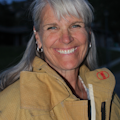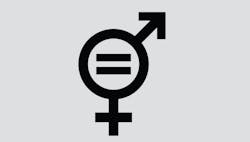Gender Disparity in the Fire Service
I was standing in the concessions line at my daughter’s baseball game when I overheard a conversation between two young boys in front of me. I heard one say to the other, “My dad says there’s nothing worse than getting beat by a girl.” I couldn’t resist this underhand pitch and quickly responded, “Well, you better get used to it.”
Although this was a somewhat comical moment, the reality is that there’s a continuum of dialogue—that starts with our youth—that still promotes disparate value between women and men. As long as we continue to focus on one gender having greater value over the other in this manner, we cannot act surprised when gender-based discrimination rears its ugly head in the fire service. Promoting the notion that one gender has greater value over the other eclipses the true value of either group. Women are not able to reach their full potential, and men, unfortunately, deviate from their better selves. Both result in an overall lessening of the whole.
Keeping groupthink in check
We’ve all heard the expression “women are from Venus and men are from Mars.” Big deal. Those of us in fire and EMS may indeed be different physiologically, emotionally and physically, but for as many overt differences as there are between men and women, there are as many or more differences between all individuals regardless of gender, race or background. It is stunning that we’re still having this conversation in 2016, but the lawsuits keep coming, and the fire service keeps making the news as we continue to exercise poor judgment and an apparent inability to put our differences aside and do our jobs.
The nature of the fire service positions us for greatness or embarrassment. Small ideas, whether productive or damaging, develop through our team mentality. When misdirected, it’s referred to as “groupthink,” and it’s important to be aware of it before we’re overrun by it. Irving Janis first introduced the concept of groupthink in 1972. According to the organization Psychologists for Social Responsibility, quoting part of Janis’ book, groupthink occurs “when a group makes faulty decisions because group pressures lead to a deterioration of ‘mental efficiency, reality testing, and moral judgment.’”1 The same organization indicates that the groups that have been identified as particularly vulnerable to groupthink are those that “ignore alternatives and tend to take irrational actions that dehumanize other groups,” and that the groups most susceptible to groupthink are typically similar in background, insulated from outside opinions and are devoid of any clear decision-making rules.
My experience has been that the majority of firefighters, women or men, come to work simply wanting to do their jobs, and it is only when a small group of individuals decide to make an issue of gender that it actually becomes one. Good leadership, either from the top or within an organization, understands how to keep groupthink in check by leveraging diversity, supporting decision-making with sound policy, and avoiding making decisions in a vacuum.
Creating opportunities and removing barriers
In this case, we’re dealing with centuries-old, gender-based cultural norms running square into a changing world supported by reason, law and desire. As long as the emergency services continue to provide service to a diverse community, leveraging and balancing the male/female perspective and attributes within the service model is a smart and reasonable approach to doing business.
Further, Title VII of the Civil Rights Act of 1964 makes it illegal to discriminate against an individual or group based on a number of protected classifications, gender being one. But most importantly, as long as women want to serve their communities as firefighters, we must provide the opportunity, ensure that they are qualified, and then find a way to optimize their contributions, as we should with any employee. As departments across the country move to recruit women into the fire service, there is still little support for ensuring sustainability. If we continue to bring women into an environment devoid of opportunity, our efforts will be futile, and it will continue to be a hurtful and expensive practice for all parties concerned. You cannot plant the seed of diversity in untenable soil.
All people have basic human needs. Consider Maslow’s hierarchy of human needs and you’ll see that there is no differentiation between a woman’s basic human needs and a man’s. Ultimately we all need to meet our biological needs, feel safe, have a sense of love and belonging and develop self-esteem in order to ultimately reach self-actualization.2 Although anecdotal, most rational individuals—when provided equal opportunity to education, training, special assignments and promotions—accept the challenge of fair competition. In doing so, the rub between men and women in the fire service greatly diminishes. However, through her research, Dr. Barbara Russo, PhD has identified several specific barriers within the fire service that are present for women and not necessarily their male counterparts. In her doctoral dissertation, Women Firefighters’ Strategies for Advancement in the Fire Service: Breaking Down Barriers in Gender-Based Occupations, she identifies some of those barriers as sexual discrimination, sexual harassment, denial of professional development and a measurable glass ceiling at the rank of captain.3
When women and men work together, it is impossible to just shut off human nature; however, as professionals, we had better figure out how to manage it. We will always face issues of sexual attraction, competition and, frankly, centuries of gender-based cultural norms. Gender identifiers in firefighting are strong. It is a physically demanding job that has been, and in all likelihood, will always be a male-dominated profession. Knowing that women will always be outnumbered and that the environment is ripe for groupthink tendencies are all the more reasons to ensure that the work environment is safe and productive, and provides the same opportunities for all members.
Connecting to recent events
We have to be willing to talk about our profession specifically as it relates to the gender acceptance gap in this country. According to a recent article in the Washington Post by Petula Dvorak, when it comes to workplace harassment, “… it’s especially prevalent in firefighting, where I found case after case—in Rhode Island, Arizona, Utah, Florida—of women winning sexual harassment cases against their departments in just the past couple of years."4 This should make us all blanch. These are taxpayer dollars that could be put to good use within our communities. Instead, we continue to ruin lives and careers and then try to fix the damage with remuneration, as was the situation with a recent case in Rhode Island where a retired Providence fire lieutenant was awarded more than $800,000 after jurors found that she had endured both sexual harassment and retaliation while on the job.5
Although this feels like a variation of the movie “Groundhog Day,” recent events call leadership within the fire service to tackle this issue with fervor. The very core of this matter goes back to the choices we make when it comes to how we view and treat each other. As described with groupthink, the dehumanizing or objectifying of other individuals rarely ends well. In the book, Leadership and Self-Deception, the Arbinger Institute explores the moment when we make the decision between right and wrong, and the subsequent stream of justification that follows. When we don’t see each other as equals, there is a cascading impact on the decisions we make and consequences that result. When we’re in that mindset, it is referred to as “being in the box” toward someone. There are ways to get out, but you must first be willing to recognize that you’re in.
Concluding thoughts
The advice will flow freely in the coming months, arguing the need for better oversight; stronger, more binding policy; and more open access for the victims to the assistance they need. But this is personal and we need to make it such. The most egregious gender-based experience I’ve had was at the hand of a man who outwardly adores his daughter. As I watched how he treated me, and other women at work, I couldn’t help but wonder how he would respond if his daughter were subjected to the same kind of treatment, as Chief Billy Goldfeder wondered in a recent blog.6 It is everyone’s responsibility to take on this issue. Leadership at all tiers must recognize groupthink and gender-based disparate treatment and have the courage to step in front of it. There are no entitlements for one class over another. This is not a call to coddle or to tip the scales in favor of women. This is a call to wake up to the humanity that has been eluding us. This is the battle cry that screams, “We’re better than this!”
References
- Psychologist for Social Responsibility. What is Groupthink. http://www.psysr.org/about/pubs_resources/groupthink%20overview.htm
- McLeod, S. Maslow's Hierarchy of Needs. 2014. http://www.simplypsychology.org/maslow.html#self2
- Russo, BR. Women Firefighters’ Strategies for Advancement in the Fire Service: Breaking Down Barriers in Gender-Based Occupations. ShareOK. December 2013. https://shareok.org/bitstream/handle/11244/15098/Russo_okstate_0664D_13030.pdf?sequence=1
- Dvorak, P. “Was a Va. firefighter humiliatied by co-workers online before she killed herself?” Washington Post. April 25, 2016. https://www.washingtonpost.com/local/was-a-va-firefighter-humiliated-by-co-workers-online-before-she-killed-herself/2016/04/25/c444e426-0af9-11e6-8ab8-9ad050f76d7d_story.html
- Davis, K. “NBC 10 I-Team: Female firefighter awarded $800K in sexual harassment suit.” April 18, 2016. http://turnto10.com/news/local/female-firefighter-awarded-800k-in-providence-sexual-harrassment-suit
- Goldfeder, B. “So … How’s Your Daughter?” Fire Engineering. April 27, 2016. http://www.fireengineering.com/articles/2016/04/goldfeder-commentary.html
About the Author

Martha Ellis
Martha Ellis has been in the fire service for 23 years. She has worked as a hot shot wildland firefighter and has served as a structural firefighter for nearly 22 years in the Salt Lake Valley. She holds a master’s degree in homeland security from the Naval Postgraduate School, a graduate certificate in conflict resolution and mediation from the University of Utah, and is a certified facilitator with the Arbinger Institute. She was also one of four recipients of the Harvard Kennedy School of Government fire service fellowship awards in 2012.
